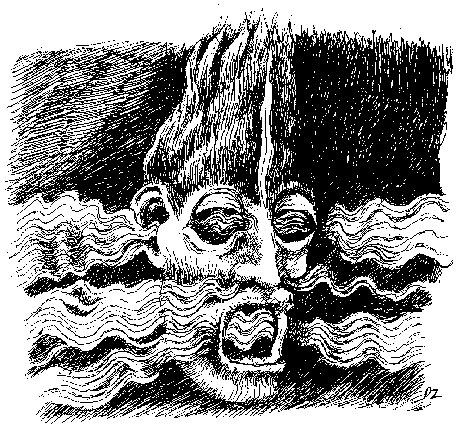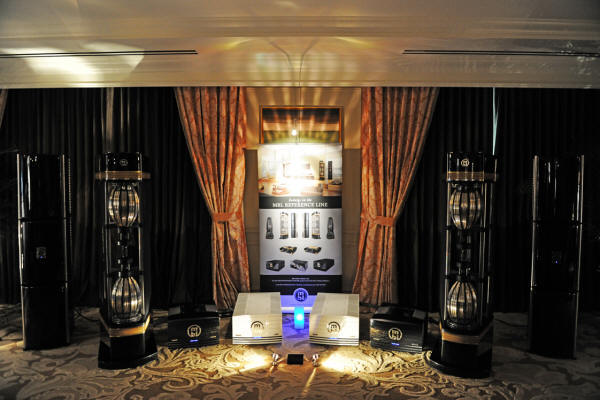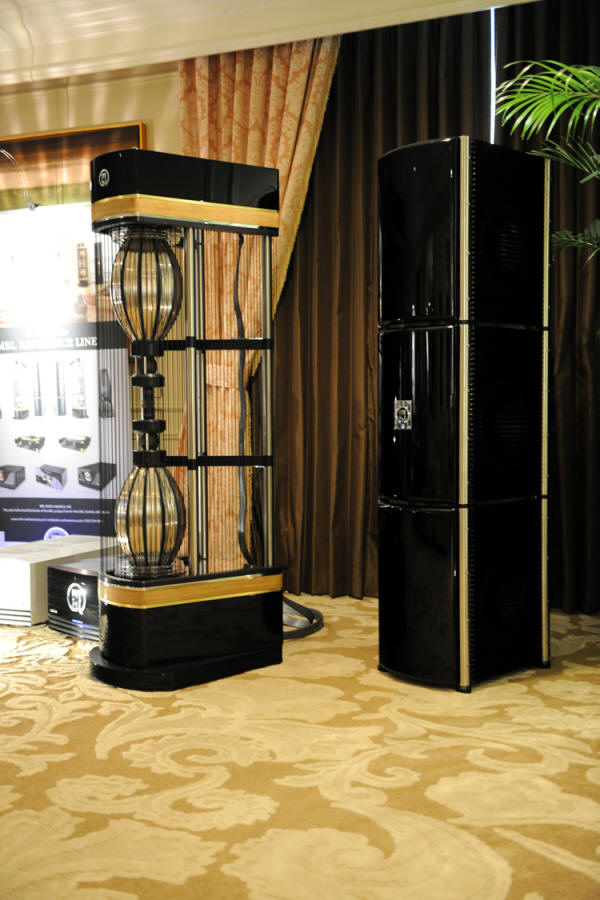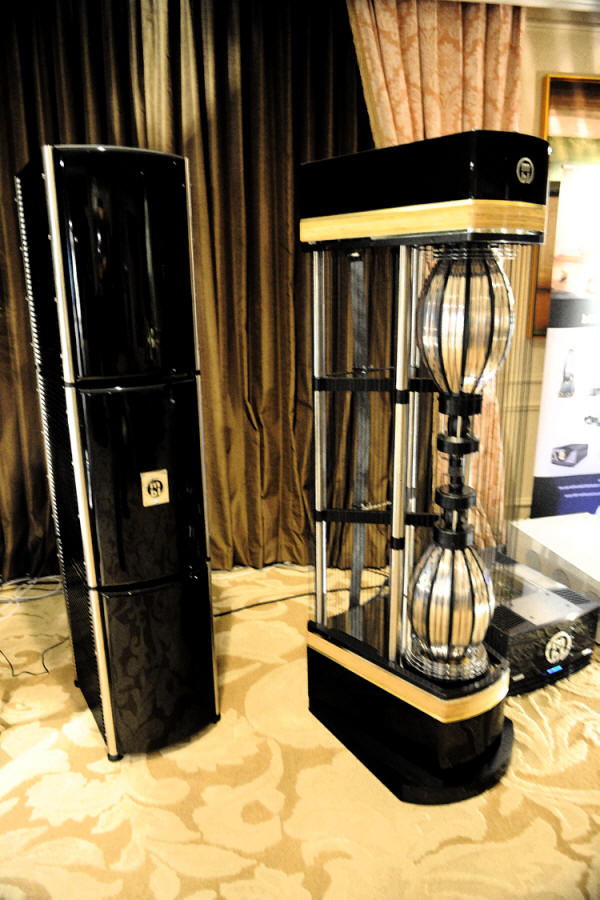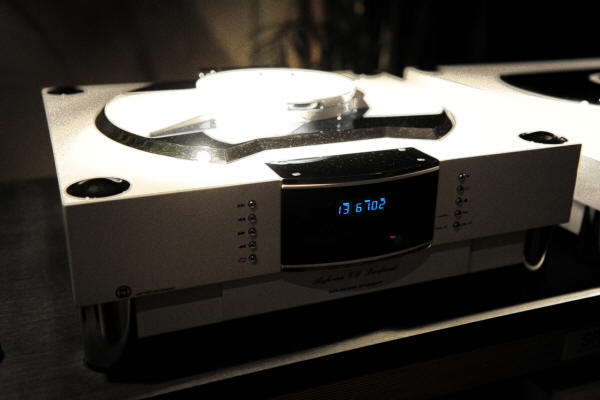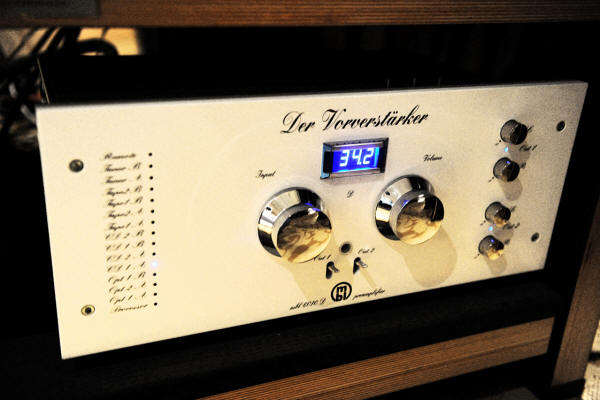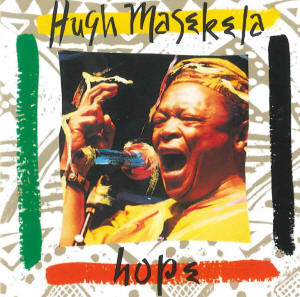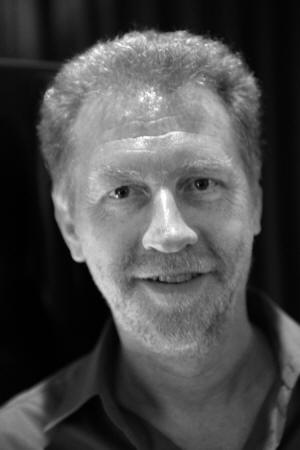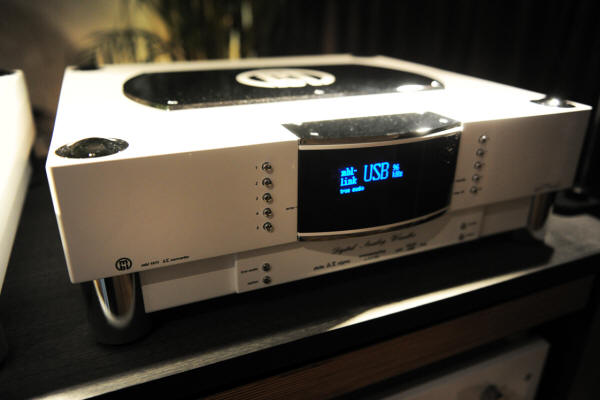|
You are reading the older HTML site
Positive Feedback ISSUE 67
Impressions: My X-treme X-perience with the mbl 101 X-treme Loudspeakers [All photographs and image processing by Robinson; cartoon by Daniel Zimmerman]
In which our hero meditates… Most audio reviewing is an exercise in "variations on a theme." Improvs, different takes on classic designs, new perspectives on things both old and new… a tweak here, a mod there, repackaging, and even incremental gains from time to time. There are improvements, but many of these are relatively modest. No matter what some audio reviewers may say… and they will be saying such things, poor creatures…there are very few "game-changers" in fine audio. Fundamental advances are rare, and unless you want to rob your words of all meaning, you learn to be cautious and stinting in your resort to superlatives. Otherwise, like the boy crying "Wolf!" too often, your hyperbole is the death of your credibility. Lord knows, there are some folks with dead-as-a-doornail credibility in high-end audio commentary. The noise floor is pretty high in places; the signal-to-noise ratio, pretty poor. Too much bustle; too much exaggeration; too much urban legend and ad-hominem drive-by-postings; too many self-appointed "experts." And far too little time to reflect. Everyone wants everything NOW. To hell with all of that.
The MBL eXtreme 101 loudspeakers with their bass columns; between are a pair of 9011 monoblock amplifiers (in white), and a pair of 9008 monoblocks (in black). On the other hand, sometimes you get to experience an audio something that's truly special, a product that keeps experienced sensibilities from feeling jaded, and reminds you of the joy that exceptional performance demands from even the most demanding audiophile and music lover. I've had a few of these experiences over the years, but I do admit to their rarity. The darTZeel NHB-18NS preamp and NHB-108 stereo amp with the Evolution Acoustics MM2 loudspeakers fed by the Playback Designs MPS-5 with USB-X interface or the Wave Kinetics NVS turntable with Durand Telos tonearm and Ortofon Anna MC is one; the MBL Reference System that is currently in my listening room (Radialstrahler 101E Mk. II speakers, 9011 monoblocks, 1611 and 1621 digital front end) is definitely another. The combination of YG Acoustics Anat III Pro Signature speakers with the Tenor 350W monoblocks, darTZeel NHB-18NS preamp, and Kubala-Sosna cables was likewise really delicious. I should also mention the Boulder Amplifier 2060 and associated reference preamp and digital; and the very fine Wavac HE-833 v1.2 SET system with PRT-1 preamp. After that, my listening room experiences begin to tail off towards good, but lesser systems/components. Historically, and elsewhere, I can say that the mbl 101 X-treme system ranks up there in the audio stratosphere with my listening session at Peter Evans' place years ago. I was with Scott Frankland, Brian Hartsell, and Tom Davis, listening to the Maggie MG-20s, tweaked out by George Cardas, hooked up to the magnificent Wavestream Kinetics V-8s, etc…. yep, that was a magnificent night… right up on the mountain top. George Cardas' listening room back in the early ‘90s was always a feast; and both Winston Ma and Mike Lavigne have provided me with wondrous moments in their rooms. (In fact, I plan to return to Mike Lavigne's place this summer to check out the extraordinary combination of the rare darTZeel 458 monoblocks and NHB-18NS preamp with the spectacular Evolution Acoustics MM7 speaker system, fed by Playback Designs and Wave Kinetics NVS/Durand/Ortofon, as well as several Studer and Ampex RTR decks. Should be choice, especially lightly doused by fine single malts.) I'm leaving audio shows out of consideration here, as being a real mixed bag, and too hard to gauge when it comes to transformational listening. Show listening is a collection of compromises, some quite severe; it's like listening to music in a car. That's a fair amount of experience over the past 24 years. But it's still not an exceptional number of trips to mountaintops, despite all of my efforts to train my sensibilities. But…! But I did have one of these experiences at CES 2013, when, at the invitation of MBL, I made a special visit to the main MBL room, and spent hours listening to the mbl X-treme 101 loudspeaker system. I am always willing to listen to designs that I suspect will be potentially significant; higher audio education never ends. Or if it does, you need to think about retiring from serious audio commentary.
Jeremy Bryan, President of MBL North America, enjoying some fine Pacific NW Cabernet Back in the summer of 2012, Jeremy Bryan, President of MBL North America, visited Portland. This was to oversee the installation of the MBL Reference system mentioned above, a complex task. (My reflections on the MBL Reference system will appear later this summer.) Jeremy and I got to know each other pretty well… he's a great fellow, who really knows what audio excellence is, and has a rare set of ears. No, not everyone in this biz does. After getting the Radialstrahler 101E Mk. II's in place… no small feat… Jeremy mentioned later that MBL would be showing their ultimate reference speakers, the eXtreme 101's, at CES 2013. It was going to be the only time that MBL would do a setup of the beasties, since they require such effort and expense to get into place; I should really come by and check it out, it made everything else sound a bit broken, etc. I said that I would try, though I didn't know if I would be able to make it. CES comes at an awkward time of year for me, and Las Vegas is a depressing city: a showcase and distillation of all that's tawdry and superficial in American culture. On the other hand, I was truly interested in hearing the eXtremes, since I had heard such very good things about them over the years. Whenever I've had an opportunity to extend the calibration of my listening experiences, I've tried to do so… As it turned out in the course of things, MBL gave me a special invitation to make a trip to CES 2013 at Las Vegas. Topping on the cake was the fact that Jürgen Reis, the long-time chief brilliance behind the MBL designs, would be there, and wanted to do an interview. "Well… there it is!" – Emperor Joseph II, in Amadeus That decided me to do it. And, as it turned out, it's a very good thing that I did.
The majestic mbl 101 X-treme loudspeaker, a two-part study in true authority… After a very crazy taxi ride… typical for Las Vegas during CES…I arrived at the Venetian Towers in the late morning, and met Jeremy Bryan. Upstairs we went, to get into the listening as soon as possible. The MBL room at the Venetian was larger than the usual spread. According to MBL North American President, Jeremy Bryan, the room was "30' x 21' x 10' ceiling. Speakers on long wall." But the room was larger than that actually; "There was a large foyer on one side, so the cubic volume is larger than the simple numbers indicate." Indeed. I remember quite a large space, not the sort of thing that you usually see in most audio shows, both due to the audio challenges and the sheer cost of the room space. And that's when a hotel is large enough to have such facilities in the first place. Frankly, this is the sort of space that would normally devour most audio systems; there's simply too much volume to drive without taxing the playback chain. Either the amps will start to overload, become shrill, or actually clip, or the speakers will hit their maximums and tap out without filling the room. Larger rooms like this one require some serious designs to transform the experience from disappointment to pleasure.
The MBL 9011 monoblocks, in white and chrome, front-and-center; they are flanked by a pair of mbl 9008 A monoblocks, finished in black and chrome. My experience: a full-range and truly reference-grade audio system (a rather rare beast) requires highly capable speakers, capable of handling a very wide frequency range…say, from about 15Hz or so, out to 40kHz, plus/minus a few dB, with higher frequency being better in these days of Double DSD, open reel tapes, and the best LP playback in history. Additionally, it is essential that the system be as correct in the phase and time domains as possible. (This is a lot more rare than you might think.) With all due respect to my low-powered SET friends, this usually means tons of high-speed horsepower, and large, more complex speaker arrays. Most companies simply cannot produce to these general target specifications. And most consumers would not be able to afford the results, even if they could. It takes more than aspiration to put together the technical resources, the funding, and—most importantly—the sensibilities to achieve this highest level of the audio arts. Generally speaking, you're well beyond the "garage lab" level of operations before you can even begin to think about vaulting this bar. That limits the game pretty immediately.
The mbl 101 X-tremes, in stile fresco… One of the relatively few companies that have done this successfully is MBL. Having been in operation for several decades, and having maintained the necessary level of commitment and technical excellence, the MBL line reflects a deep understanding of the issues involved in achieving the highest in the audio arts. I've been following them with real interest for years now, and have had their reference line for extended sessions in my listening room twice (2008 and 2012-2013). The supreme quality of their work is unmistakable. MBL certainly brought the goods to the Venetian. The 101 eXtremes were being driven by two dual monoblock pairs: a pair of the big-boy 9011s, and a pair of the 9008 A monoblocks to drive the eXtreme 101 bass columns. MBL's Jeremy Black explained the configuration to me in this way: "The active subwoofer section of the X-treme is literally made up of three independent chassis of 2 x 12" aluminum membrane woofers firing "push-push" off the sides of the independent woofer cabinet structure. Each pair of these woofers is connected inside the cabinet at the backs of the drivers so they support and work to cancel one another's back forces (a similar trick is used in the hybrid Radialstrahler 111 F and 120, which also use this connected driver scheme in the woofers and subwoofers). One of the three independent chassis (per channel) contains the input/amplifier section…AC input, RCA, and XLR input (mono), power switch, overall volume control, group delay control, and "Q" adjustment for fine tuning of the system in its location and proximity to the Radial towers. This distance can vary quite a bit (up to about 30' successfully), allowing the customer to put the woofer towers in various areas to get better bass response, better views, better visuals for the significant other, etc. The amplifier is an A/B design derived from the 9011 and literally coasts, even controlling 6 x 12" woofers, as you heard. Ideally, the three woofer cabinets stack on top of one another (they weigh over 300 lb. each, so this gets very tricky for the upper two) so you have a line source (man-sized) subwoofer that functions and is controlled independent of the Radial towers. This allows them to be placed for ideal imaging/focus and to tailor to the customer's taste and room limitations. You can also place the woofer chassis single or double stacked. They connect to the main chassis with the amp/controls via special Neutrik-connected jumpers. A bit of clarification is needed here about the "columns." The X-treme has two Radialstrahler towers (which really are four Radialstrahler arrays (woofer, midrange tweeter, each of the four has its own crossover (jumpers, too, as in the 101 E MKII) and speaker terminals), which could be called "Radialstrahler Mirror Arrays" because this is literally 4 independent loudspeakers. Each has the lowest impedance point around 3.4 Ohms. Our 9011 is most stable at 2 Ohms, and the 9008 A is very close…many, many amp manufacturers make bold claims that a Radialstrahler will show as untrue. For this reason, we recommend the X-treme Radial towers are powered ideally with 4 x 9011 monoblock amps…totally stable for any load and just coasting…allowing the music to breathe and wash over the listener in a more effortless way, which is a lot of the reason it sounds so convincing. Second choice is 2 x 9011 on the lower arrays and 2 x 9008 A on the upper arrays…the third choice is 4 x 9008 A. Some customers want a single pair of 9011 driving both arrays, but this takes the impedance (summed) to 1.7 Ohms…very tricky territory for any amplifier with any claims. It can work, but at louder levels in larger rooms it can sound a bit strained (this is not the speaker; this is the amplifier being taxed by the load). So, here in Vegas, we used a pair of 9011 on the lower arrays (closest to ear height) and a pair of 9008 A on the upper arrays." The front end included their very fine 1621 CD transport and 1611 DAC, flowing to the MBL 6010D reference preamp. The 1611 DAC is capable of handling high-resolution PCM files out to 192kHz/24-bit via USB 2.0, which is most of what I listened to for the many hours that I was in the MBL room. This is the best-of-the-best that MBL has to offer right now, and I was entranced.
The MBL 1621 CD transport The results in this large room under show conditions were not merely "very good," or "excellent"… they were startling.
MBL's spectacular 6010D reference preamp: I/O to go! The sheer scale of the music was paradigm-shifting. The room seemed to light up effortlessly with the high-resolution digital playback that Jeremy kept flowing in the room. Listening to Hugh Maskela's album Hope, for example, was a fantastic experience.
Several times I caught Maskela's heart-breaking song "Stimela (The Coal Train)"… even allowing for the fact that the version that Jeremy had was PCM, the emotional effect of the MBL eXtreme system was like a tsunami, filling the room and all the souls therein with the power of Maskela's musical art. The heavy percussives; the cool-heat of the passionate words and chords; the soaring, searing brass of the trumpet… all was made clear. It was nothing less than riveting for me; I sat in the front row, and re-calibrated my sense of musical scale in audio reproduction. The soundstage wasn't "from here to there, and yeah, over there too"… it simply was. The eXtreme 101 system wasn't hulking it… it wasn't playing Godzilla-in-the-streets-of-Tokyo with the music. Instead, the massive eXtremes simply seemed to vanish into the music. Not simply reproducing the music… they were embodying it…evoking it. Naturally, this meant that imaging was spot on. To the limits of the recordings, I could locate performers in space, and feel their audio locus. I was bemused by the feeling that this gave me… like sitting in a studio or hall while a recording was being made, and being able to open and close my eyes while the performance and the recorder were rolling. The depth of things, to the limits of PCM sources, was exceptional, which added to the impression. That's not surprising, though; both the Radialstrahler 101E Mk. II's and (especially) the eXtreme 101's omnidirectional nature produces a roundness and depth of image that must be heard to be believed. The quickness of the 6010D preamp and the 9011/9008 amps was flawless. There was no sense of sluggishness whatsoever. I've become mightily impressed with the 1621 CD transport, but even more with the 1611 DAC and its USB 2.0 input. High-resolution PCM was still PCM, but arrived with a very pleasant amelioration of the worst edginess and digital glare. I attribute this to MBL's chief designer and engineer, Jürgen Reis, and his use of state-of-the-art Delta-Sigma processing. Reis' 1611 uses a highly complex system to evaluate PCM audio signals, and is able to use DSD-type processing up to 5.6 mHz (the equivalent of 128fs, or Double DSD) in playback. This is exceptionally effective in making PCM behave itself much more than it otherwise would do. It's less desirable than having Double DSD via USB 2.0 in the first place, but allows us to live with PCM with less hostility.
Jurgen Reis, the design genius behind MBL, at CES 2013 (portrait by David W. Robinson) The MBL electronics were quite detailed, but delivered without any stereotypical solid-state harshness, hash, or grain. No romance, either, though. The recordings were presented with a clear-eyed detail, but without a touch of amusicality… again, apart from the limitations of the PCM sources in play. My key audio virtue for quite a while has been that of transparency… the ability of a component or system to vanish, to simply convey a recording without qualifying or editorializing about it. No euphonics; let that happen at the level of the original microphony and audio engineering/mastering. Which the mbl 101 X-treme system did in spades, recording after recording. It's wonderful to have the luxury of sitting in a stellar audio demo room during a show and spending hours there. As the hours passed, and the music flowed, all the while sitting here and there in the demo room, it became obvious to me that the 101 X-treme system didn't have any weaknesses that I could detect. Instead, the impression of true mastery of the recordings became stronger and stronger… and finally inescapable. And that's really rare for me, Cuz.
The brilliant MBL 1611 Delta-Sigma converter in USB 2.0 mode via the MBL-link technology There wasn't any "here" or "there"; there was just the music. In fact, the only thing that I was missing was the ultimate ease and naturalness of DSD and Double DSD to complete this picture. Apart from that, I couldn't find a single thing to fault in the mbl 101 X-treme system… it was that good. True audio presence. No hype, no exaggeration: the mbl 101 X-treme system is paradigm-shifting—a revelation of the possibilities of the audio arts. I don't think that I've ever said that in a very long time… not since the Magnepan MG-20s in Peter Evans' room, back in the mid-90s. So, what else is there to say? I'm overwhelmed by what I heard at CES 2013 in the MBL room. The 101 X-treme speakers and related MBL components commanded immense respect. The magnificent scale of the audio space… the deftness of all audio virtues… and the ability of such an enormous speaker system to vanish into the music, even with PCM sources, was unique in my experience. A true audio marvel… a transforming experience. Pay attention, amigos: I have to put the MBL 101 X-treme system in the very top tier of my audio experiences. If you haven't heard it, you should treat yourself at the next audio show in which they are in action. At the current time, that would be either the Munich Show, or CES. Plan accordingly. Retail:
MBL eXtreme 101 loudspeakers: USD $263,000 (black and gold; white and chrome @
USD $271,000)
MBL Akustikgeraete GmbH & Co KG Distributor
Distributed in the USA by MBL North America, Inc., a wholly-owned subsidiary of
MBL Akustikgeraete
|

